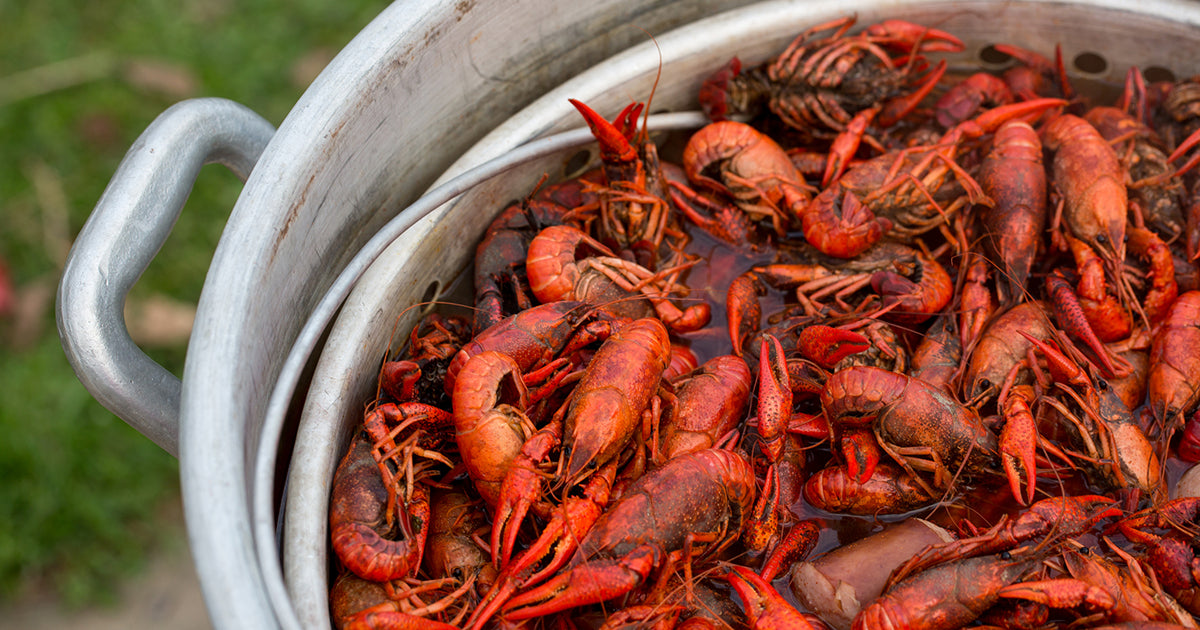Quick Crawfish Guide

Crawfish season is short and making the most of your crawfish requires knowing how to handle them from start to finish. Let us walk you through these essential steps, beginning with proper storage to keep your crawfish fresh. We'll then dive into how to boil crawfish and how to tell when they are done. We will also share some of the best techniques for cracking, peeling, and savoring every last morsel of these delicious crustaceans.
Live Crawfish Care
Crawfish are best cooked the day they arrive, but if needed, follow these storage tips:
- Keep live crawfish in the sack they came in or place them in a ventilated cooler.
- Do not submerge them in water, as they need air to survive.
- Store them in a cool, damp place (ideally 40º-50ºF). A damp towel over the sack helps keep them hydrated.
- Optional: If storing overnight, rinse them once with cold water to remove mud and debris.
- Cook the next day for the best quality.
How Much Crawfish to Serve?
- 3-5 lbs of whole crawfish per person.
After boiling, let the crawfish soak in seasoned water for 15-30 minutes before serving.
How to Boil Crawfish
Seasoning: For 15 lbs of crawfish, use 1 lb of crawfish boil seasoning
- Clean crawfish thoroughly by rinsing them in fresh cool water*.
- Fill your pot halfway with water, just enough to cover the crawfish you’ll be adding in step 4 (approximately two quarts of liquid for every pound of crawfish).
- Light the burner and wait for the water to begin boiling. This can take 20-30 minutes.
- Once the water is rapidly boiling, add the crawfish, then cover with a lid. Wait for the water to return to a boil.
- Let the crawfish boil for no more than 3 minutes**. They will continue to cook as you remove and season them in the next few steps.
- In the meantime, sprinkle a light layer of crawfish boil seasoning into your clean cooler. Add your boiled crawfish and then add another layer of seasoning on top. Do this in increments, typically 1 pound of seasoning for every 15 pounds of crawfish.
- Close your cooler and shake it to thoroughly mix everything together.
- Keep the cooler closed for about 15 minutes and to allow the flavors mix together.
- Platter your crustaceans and call everyone around to begin your feast!
Make it your own:
- Purchase extra seasoning to season the water ahead of boiling – make sure to stir it in.
- Add garlic, lemon, and some of your favorite vegetables (we like potatoes, corn, and onion!) into the seasoned, boiling water — just make sure that you don’t overcook them!
- Add extra seasoning and your favorite hot peppers to kick it up a notch - for those that like some heat.
*Our crawfish come washed but a nickname for crawfish is “mudbugs” so they may still need a brief wash.
**Add an extra minute for the large (select) size crawfish.
How to Tell When Crawfish Are Done
Cooked crawfish turn bright red when fully cooked. The best way to check for doneness is to gently pull the tail away from the body—if it separates easily and the meat inside is firm and opaque, they’re ready to eat.
Time Table for Boiling Crawfish:
- Medium Crawfish: 3-4 min after water returns to a boil
- Large Crawfish: 5 min after water returns to a boil
How to Eat Crawfish
- Grab the Crawfish: Hold the crawfish firmly with both hands, gripping the tail with one hand and the head with the other.
- Twist & Pull: Gently twist and pull the tail away from the head to separate them.
- Suck the Head (Optional): If you want the full Louisiana experience, suck the juices from the crawfish head for extra flavor.
- Peel the Shell: Pinch the bottom of the tail and peel away the shell by pulling it off with your fingers.
- Pinch & Pull the Meat: Once the shell is loosened, pinch the end of the tail and pull out the tender, juicy crawfish meat.
- Enjoy & Repeat!: Dip in butter, sauce, or enjoy as is. Then grab another and keep going!
Pro Tip: If the crawfish is large, you can also gently devein it by pulling the dark vein off the back before eating.
